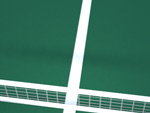Tennis

Topspin
In ball sports, topspin is a property of a ball that rotates forwards as it is moving. Topspin on a ball propelled through the air imparts a downward force that causes the ball to drop, due to its interaction with the air. Topspin is the opposite of backspin.
In tennis, because of a net being in the middle of the court, using topspin will increase the player's consistency. Topspin also allows a player a greater margin of error. Because topspin brings the ball down toward the ground quicker, a player can hit the ball higher over the net, thus increasing the margin of error. This may help in lobbing an opponent who is waiting at the net, or playing directly to a player's feet. Hitting low to high as the player approaches the contact point will impart lift. Keeping the racquet face (the strings) slightly closed from perpendicular will impart the topspin to the ball that the player wants. However, balls that bounce lower due to greater force or backspin are much more difficult to return using a grip that confers topspin such as the semi-western and western grips, as the racket is angled too far downwards to 'lift' the ball back over the net. As such, topspin is more effectively used on slower, higher bouncing surfaces such as clay. Topspin is also far more difficult to impart on backhand strokes due to the physical limitations of an arm stretched across the body.
Physical explanation
Topspin on a shot imparts a downward force that causes the ball to drop, due to its interaction with the air. In racquet sports, it can be generated by hitting the ball with an up-and-forward swing, with the racquet facing below the direction it is moving. A topspin shot is the opposite of the slice; topspin itself is the opposite of backspin.
One way of explaining the Magnus effect is that - because of the rotation and the fact that air acts as a viscous or "sticky" substance on the surface of the ball, a stream of air in the wake of the ball is being ejected upwards. As a reaction to this, the ball is pushed downwards.
Often Bernoulli's principle is used to explain the topspin effect, as the difference in speed between ball surface and air is greater on the top of the ball. For example, if the air flowing past the bottom of the ball is moving faster than the air flowing past the top then Bernoulli's principle implies that the pressure on the surfaces of the ball will be lower below than above. In other words, since there is more air friction occurring on the top surface of the ball compared to the bottom, this differential causes a greater pressure to be applied on the top of the ball, resulting in the ball being pushed down.
Competitive utility
The topspin shot is very effective on hard surfaces. The ball spins forward and descends toward the ground quicker, so it can be hit with more force compared to another type of shot.
On most court surfaces, topspin also makes the ball bounce higher. As a result, it is often used on clay or "soft" court surfaces which have a naturally higher bounce, in order to make the ball harder for the opponent to hit. An opponent with a one-handed backhand is especially vulnerable to a topspin shot because it is difficult to hit a high ball with a one-handed backhand.
SPORTS

RESOURCES
This article uses material from the Wikipedia articles "Tennis" and "Topspin", which is released under the Creative Commons Attribution-Share-Alike License 3.0.
© Stories Preschool. All Rights Reserved.









